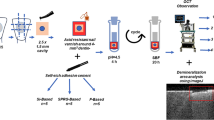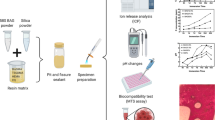Abstract
This study aimed in evaluating the effects of two experimental resin bonding systems containing conventional Bioglass 45S5 (BAG) or Zinc-polycarboxylated bioactive glass (BAG-Zn) micro-fillers on the resin-bonded dentine interface after storage in a simulated body fluid solution (SBFS). Three resin bonding systems were formulated: Resin-A: (BAG containing); Resin-B; (BAG-Zn containing); Resin-C (no filler). The ability of the experimental resins to evoke apatite formation was evaluated using confocal Raman spectroscopy. Acid-etched dentine specimens were bonded, and prepared for AFM/nano-indentation analysis in a fully-hydrated status to evaluate the modulus of elasticity (Ei) and hardness (Hi) across the interface at different SBFS storage periods. Further resin–dentine specimens were tested for microtensile bond strength after 24 h or 3 months of SBFS storage. SEM examination was performed after de-bonding and confocal laser microscopy was used to evaluate the ultramorphology of the interfaces and micropermeability. The resin A and B showed a consistent presence of apatite (967 cm−1), reduced micropermeability within the resin–dentine interface and a significant increase of the Ei and Hi along the bonded-dentine interface after prolonged SBFS storage. Bond strength values were affected by the resin system (P < 0.0001) and by storage time (P < 0.0001) both after 24 h and 3 months of SBFS storage. In conclusion, resin bonding systems containing bioactive fillers may a have therapeutic effect on the nano-mechanical properties and sealing ability of mineral-depleted resin–dentine interface.






Similar content being viewed by others
References
Tay FR, Pashley DH. Guided tissue remineralisation of partially demineralised human dentine. Biomaterials. 2008;29:1127–37.
Liu Y, Mai S, Li N, Yiu CK, Mao J, Pashley DH, Tay FR. Differences between top-down and bottom-up approaches in mineralizing thick, partially demineralized collagen scaffolds. Acta Biomater. 2011;7:1742–51.
Peters MC, Bresciani E, Barata TJ, Fagundes TC, Navarro RL, Navarro MF, Dickens SH. In vivo dentin remineralization by calcium-phosphate cement. J Dent Res. 2010;89:286–91.
Bresciani E, Wagner WC, Navarro MF, Dickens SH, Peters MC. In vivo dentin microhardness beneath calcium-phosphate cement. J Dent Res. 2010;89:836–41.
Moshaverinia A, Ansari S, Moshaverinia M, Schricker SR, Chee WW. Ultrasonically set novel NVC-containing glass-ionomer cements for applications in restorative dentistry. J Mater Sci Mater Med. 2011;22:2029–34.
Dickens SH, Flaim GM. Effect of a bonding agent on in vitro biochemical activities of remineralizing resin-based calcium phosphate cements. Dent Mater. 2008;24:1273–80.
Dickens SH, Flaim GM, Takagi S. Mechanical properties and biochemical activity of remineralizing resin-based Ca-PO4 cements. Dent Mater. 2003;19:558–66.
Ryou H, Niu LN, Dai L, Pucci CR, Arola DD, Pashley DH, Tay FR. Effect of biomimetic remineralization on the dynamic nanomechanical properties of dentin hybrid layers. J Dent Res. 2011;90:1122–8.
ten Cate JM, van Duinen RNB. Hypermineralization of dental lesions adjacent to glass-ionomer cement restorations. J Dent Res. 1995;74:1266–71.
Tay FR, Pashley DH, Yiu C, Cheong C, Hashimoto M, Itou K, Yoshiyama M, King NM. Nanoleakage types and potential implications: evidence from unfilled and filled adhesives with the same resin composition. Am J Dent. 2004;17:182–90.
Hashimoto M, Tay FR, Ohno H, Sano H, Kaga M, Yiu C, Kumagai H, Kudou Y, Kubota M. Oguchi H.SEM and TEM analysis of water degradation of human dentinal collagen. J Biomed Mater Res B Appl Biomater. 2003;66:287–98.
Pashley DH, Tay FR, Breschi L, Tjäderhane L, Carvalho RM, Carrilho M, Tezvergil-Mutluay A. State of the art etch-and-rinse adhesives. Dent Mater. 2011;7:1–16.
Osorio R, Yamauti M, Osorio E, Ruiz-Requena ME, Pashley DH, Tay FR, Toledano M. Zinc reduces collagen degradation in demineralized human dentin explants. J Dent. 2011;39:148–53.
Hench LL & Andersson Ö. Bioactive glasses. Introduction to Bioceramics World Scientific, Singapore 1993; Hench LL, Wilson J eds: 45–47.
Edwards HGM, Carter, E.A. Biological Applications of Raman Spectroscopy. Infrared and Raman Spectroscopy of Biological Materials (Practical Spectroscopy) 2000; Gremlich, H.U., and Yan, B. eds: 421–477.
Schulze KA, Oliveira SA, Wilson RS, Gansky SA, Marshall GW, Marshall SJ. Effect of hydration variability on hybrid layer properties of a self-etching versus an acid-etching system. Biomaterial. 2005;26:1011–8.
Sauro S, Osorio R, Watson TF, Toledano M. Assessment of the quality of resin-dentin bonded interfaces: an AFM nano-indentation, μTBS and confocal ultramorphology study. Dent Mater. 2012. doi:10.1016/j.dental.2012.02.005.
Sauro S, Watson TF, Mannocci F, Miyake K, Huffman BP, Tay FR, et al. Two-photon laser confocal microscopy of micropermeability of resin-dentin bonds made with water or ethanol wet bonding. J Biomed Mater Res B Appl Biomater. 2009;90:327–37.
Bertassoni LE, Habelitz S, Kinney JH, Marshall SJ, Marshall GW Jr. Biomechanical perspective on the remineralization of dentin. Caries Res. 2009;43:70–7.
Balooch M, Wu-Magidi IC, Balazs A, Lundkvist AS, Marshall SJ, Marshall GW, et al. Viscoelastic properties of demineralized human dentin measured in water with atomic force microscope (AFM)-based indentation. J Biomed Mater Res. 1998;40:539–44.
Balooch M, Habelitz S, Kinney J, Marshall S, Marshall G. Mechanical properties of mineralized collagen fibrils as influenced by demineralization. J Struct Biol. 2008;162:404–10.
Marshall GW Jr, Marshall SJ, Kinney JH, Balooch M. The dentin substrate: structure and properties related to bonding. J Dent. 1997;25:441–58.
Engqvist H, Schultz-Walz JE, Loof J, Botton GA, Mayer D, Phaneuf MW, et al. Chemical and biological integration of a mouldable bioactive ceramic material capable of forming apatite in vivo in teeth. Biomaterials. 2004;25:2781–7.
Hench LL. Bioceramics and the origin of life. J Biomed Mater Res. 1989;23:685–93.
Zhong JP, LaTorre GP, Hench LL. The kinetics of bioactive ceramics part VII: Binding of collagen to hydroxyapatite and bioactive glass. In Bioceramics 7, eds. OH Andersson, A Yli-Urpo, 1994, pp. 61–66.
Sauro S, Thompson I, Watson TF. Effects of common dental materials used in preventive or operative dentistry on dentin permeability and remineralization. Oper Dent. 2011;36:222–30.
Sepulveda P, Jones JR, Hench LL. Bioactive sol-gel foams for tissue repair. J Biomed Mater Res. 2002;59:340–8.
Murphy S, Wren AW, Towler MR, Boyd D. The effect of ionic dissolution products of Ca-Sr-Na-Zn-Si bioactive glass on in vitro cytocompatibility. J Mater Sci Mater Med. 2010;21:2827–34.
Yamaguchi M, Igarashi A, Ychiyama S. Bioavailability of zinc yeast in rats: stimulatory effect on bone calcification in vivo. J Health Sci. 2004;50:75–81.
Tjäderhane L, Larjava H, Sorsa T, Uitto VJ, Larmas M, Salo T. The activation and function of host matrix metalloproteinases in dentin matrix breakdown in caries lesions. J Dent Res. 1998;77:1622–9.
van Strijp AJ, Jansen DC, DeGroot J, ten Cate JM, Everts V. Host-derived proteinases and degradation of dentine collagen in situ. Caries Res. 2003;37:58–65.
Chaussain-Miller C, Fioretti F, Goldberg M, Menashi S. The role of matrix metalloproteinases (MMPs) in human caries. J Dent Res. 2006;85:22–32.
Liu Y, Li N, Qi YP, Dai L, Bryan TE, Mao J, Pashley DH, Tay FR. Intrafibrillar collagen mineralization produced by biomimetic hierarchical nanoapatite assembly. Adv Mater. 2011;23:975–80.
Liu Y, Tjäderhane L, Breschi L, Mazzoni A, Li N, Mao J, Pashley DH, Tay FR. Limitations in bonding to dentin and experimental strategies to prevent bond degradation. J Dent Res. 2011;90:953–68.
Mazzoni A, Pashley DH, Nishitani Y, Breschi L, Mannello F, Tjäderhane L, et al. Reactivation of inactivated endogenous proteolytic activities in phosphoric acid-etched dentine by etch-and-rinse adhesives. Biomaterials. 2006;27:4470–6.
De Munck J, Mine A, Van den Steen PE, Van Landuyt KL, Poitevin A, Opdenakker G, Van Meerbeek B. Enzymatic degradation of adhesive-dentin interfaces produced by mild self-etch adhesives. Eur J Oral Sci. 2010;118:494–501.
Kim J, Gu L, Breschi L, Tjäderhane L, Choi KK, Pashley DH, Tay FR. Implication of ethanol wet-bonding in hybrid layer remineralization. J Dent Res. 2010;89:575–80.
Kim J, Vaughn RM, Gu L, Rockman RA, Arola DD, Schafer TE, et al. Imperfect hybrid layers created by an aggressive one-step self-etch adhesive in primary dentin are amendable to biomimetic remineralization in vitro. J Biomed Mater Res A. 2010;93:1225–34.
Toledano M, Osorio R, Osorio E, Aguilera FS, Romeo A, de la Higuera B. Garcíaet al. Sorption and solubility testing of orthodontic bonding cements in different solutions. J Biomed Mater Res B Appl Biomater. 2006;76:251–6.
Liu G, Zhao D, Tomsia AP, Minor AM, Song X, Saiz E. Three-dimensional biomimetic mineralization of dense hydrogel templates. J Am Chem Soc. 2009;29:9937–9.
Hewlett ER, Caputo AA, Wrobet DC. Glass ionomer bond strength and treatment of dentin with polyacrylic acid. J Prosthet Dent. 1991;66:767–72.
Berry EA, Powers JM. Bond strength of glass ionomers to coronal and radicular dentin. Oper Dent. 1994;19:122–6.
Yip HK, Tay FR, Ngo HC, Smales RG, Pashley DH. Bonding of contemporary glass ionomer cements to dentin. Dent Mater. 2001;17:456–70.
Acknowledgments
This work was supported by grants CICYT/FEDER MAT2008-02347, CICYT/FEDER MAT2011-24551, JA-P07-CTS2568 and JA-P08-CTS-3944. This article presents independent research commissioned by the National Institute for Health Research under the Comprehensive Biomedical Research Centre at Guy’s & St. Thomas’ Trust. The views expressed in this publication are those of the author(s) and not necessarily those of the NHS, the NIHR or the Department of Health. The authors also acknowledge support from the Centre of Excellence in Medical Engineering funded by the Wellcome Trust. The authors have no financial affiliation or involvement with any commercial organization with direct financial interest in the materials discussed in this manuscript. Any other potential conflict of interest is disclosed.
Author information
Authors and Affiliations
Corresponding author
Rights and permissions
About this article
Cite this article
Sauro, S., Osorio, R., Watson, T.F. et al. Therapeutic effects of novel resin bonding systems containing bioactive glasses on mineral-depleted areas within the bonded-dentine interface. J Mater Sci: Mater Med 23, 1521–1532 (2012). https://doi.org/10.1007/s10856-012-4606-6
Received:
Accepted:
Published:
Issue Date:
DOI: https://doi.org/10.1007/s10856-012-4606-6




